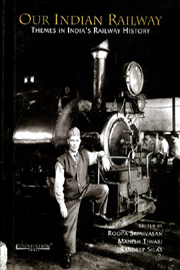Book contents
- Frontmatter
- Contents
- Foreword
- Preface
- Introduction
- 1 The Colonial Context of the Bengal Renaissance: A Note on Early Railway–Thinking in Bengal
- 2 Minute by Dalhousie on Introduction of Railways in India, as Submitted to the Court of Directors, 4 July 1850
- 3 Ackworth Committee Report
- 4 Competition and Adaptation: The Operation of Railways in Northern India: Uttar Pradesh 1860–1914
- 5 Economic Nationalism and the Railway Debate, circa 1880-1905
- 6 Railway Policing and Security in Colonial India, c. 1860–1930
- 7 Indian Nationalism and Railways
- 8 The Railway in Colonial India: Between Ideas and Impacts
- 9 The Dark Side of the Force: Mistakes, Mismanagement and the Malfeasance in Early Railways of the British Indian Empire
- 10 Tunnels and Bridges: Railways, Narrative and Power in two Novels of India
- 11 A View of the History of Indian Railways
- 12 The Romance of Steam
- Index
- Plate section
6 - Railway Policing and Security in Colonial India, c. 1860–1930
Published online by Cambridge University Press: 26 October 2011
- Frontmatter
- Contents
- Foreword
- Preface
- Introduction
- 1 The Colonial Context of the Bengal Renaissance: A Note on Early Railway–Thinking in Bengal
- 2 Minute by Dalhousie on Introduction of Railways in India, as Submitted to the Court of Directors, 4 July 1850
- 3 Ackworth Committee Report
- 4 Competition and Adaptation: The Operation of Railways in Northern India: Uttar Pradesh 1860–1914
- 5 Economic Nationalism and the Railway Debate, circa 1880-1905
- 6 Railway Policing and Security in Colonial India, c. 1860–1930
- 7 Indian Nationalism and Railways
- 8 The Railway in Colonial India: Between Ideas and Impacts
- 9 The Dark Side of the Force: Mistakes, Mismanagement and the Malfeasance in Early Railways of the British Indian Empire
- 10 Tunnels and Bridges: Railways, Narrative and Power in two Novels of India
- 11 A View of the History of Indian Railways
- 12 The Romance of Steam
- Index
- Plate section
Summary
Introduction
It is a common assumption among many historians of South Asia that the building of the Indian Railway and the arrival of modernity in Indian society were inextricably linked. From the laying of the first rail lines in 1853 in Howrah and Bombay, through the exponential growth of track mileage, the blasting of tunnels, the building of bridges, and the penetration of some of the most rugged and inhospitable terrain in the world, the railway reshaped India.
From its inception, colonial British planners viewed the railways as the cornerstone of an interconnected structure of transportation and communication, including the telegraph and postal service, which would link virtually every region of the subcontinent to the industrial economy of imperial Britain. Yet no less important to the British were the benefits the railway would provide in solidifying control over their Indian conquests and maintaining internal security in the largest and the most diverse part of their empire. In 1853, the Governor-General, Lord Dalhousie, happily reported to the East India Company's Court of Directors that the railway would allow the same quantity of military force to be deployed in a matter of days to regions that had previously required months to reach and re-supply. Movement of soldiers, armed constables, and heavy equipment could now be achieved at a speed and volume previously unimagined while senior officials could receive reports and dispatch orders within hours of trouble and over distances of hundreds of miles. Yet, only a few years after the railway was in service, some of these colonial officials must have realized that their greatest asset in maintaining control and surveillance over their Indian empire might also become their Achilles' heel.
- Type
- Chapter
- Information
- Our Indian RailwayThemes in India's Railway History, pp. 121 - 154Publisher: Foundation BooksPrint publication year: 2006

